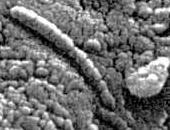Article/Document:
Scientists Find Evidence of Ancient Microbial Life on Mars
NASA Astrobiology Institute, February 28, 2001
original source | fair use notice
Summary: An international team of researchers has discovered compelling evidence that magnetite crystals in the Martian meteorite ALH84001 are of biological origin.
Text based on a NASA Ames Research Center Press Release
An international team of researchers has discovered compelling evidence that the magnetite crystals in the martian meteorite ALH84001 are of biological origin.
The researchers found that the magnetite crystals embedded in the meteorite are arranged in long chains, which they say could have been formed only by once-living organisms. Their results are reported in the February 27 Proceedings of the National Academy of Sciences.
"The chains we discovered are of biological origin," said Dr. Imre Friedmann, an NRC senior research fellow at NASA's Ames Research Center in California's Silicon Valley and leader of the research team. "Such a chain of magnets outside an organism would immediately collapse into a clump due to magnetic forces," he said.
The chains were formed inside organic material whose structure held the crystals together. "The end result looks somewhat like a string of pearls," Friedmann noted. Each magnetite crystal in the chain is a tiny magnet, approximately one-millionth of an inch in diameter. Magnetite is an iron oxide, similar to iron rust.
The chains may have served as 'compasses' for the host magnetotactic bacteria, so named because they navigate with the help of the magnetic crystal chains inside their bodies. The chains were preserved in the meteorite long after the bacteria themselves decayed.
The researchers say the magnetite chains probably were flushed into microscopic cracks inside the martian rock after it was shattered by an asteroid impact approximately 3.9 billion years ago. This cataclysmic event on Mars' surface also may have killed the bacteria. The same, or a later, asteroid impact ejected the rock, now a meteorite, into space.
Another NASA research group, led by Kathie Thomas-Keprta of NASA's Johnson Space Center, report in the same issue of PNAS that the magnetite crystals inside the meteorite are similar to those formed by 'modern' magnetotactic bacteria now living on Earth. The team studied only single crystals, however, not the elusive chain-like structures.
Friedmann's team discovered the crystal chains using a technique that enabled them to 'see' the tiny chains inside the meteorite without destroying them. Besides the chain-like formation, the team discovered that individual crystals are of similar size and shape, do not touch each other and that the chains themselves are flexible, further evidence of biological origin.
"Until now, studying life has been like trying to draw a curve using only one data point—life on Earth," said Friedmann. "Now we have two data points to draw life's curve." The next step is to find the remains of the bacteria themselves, he said.
The fact that a small (about 4-pound) meteorite from a planet contains large numbers of bacteria suggests that such bacteria were widespread on the surface of Mars, the researchers say. A stone of similar size from Earth would contain many bacteria.
In addition, since magnetotactic bacteria require low levels of oxygen, this finding indicates that photosynthetic organisms, the source of oxygen in the atmosphere, must have been present and active on Mars 3.9 billion years ago.
"Finding evidence of life on Mars is one of the central problems in astrobiology research today," said Dr. Michael Meyer, head of NASA's astrobiology program, which funded the research.
In addition to his fellowship at NASA Ames, Friedmann, who is best known for discovering microorganisms living inside desert rocks, is professor emeritus of biological science at Florida State University. Members of the research team include Dr. Jacek Wierzchos (University of Lleida, Spain), Dr. Carmen Ascaso (CSIC, Madrid, Spain), and Dr. Michael Winkelhofer (University of Munich, Germany).
The meteorite ALH84001 was found in the Allen Hills region of Antarctica in 1984 by researchers supported by the National Science Foundation's Antarctic Search for Meteorites Program, a joint effort by the NSF, the Smithsonian Institution and NASA. Case Western Reserve University in Cleveland manages the program.
Read more articles on this topic:






